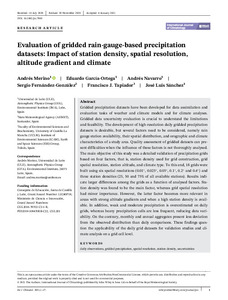Por favor, use este identificador para citar o enlazar este ítem:
http://hdl.handle.net/20.500.11765/12685
Evaluation of gridded rain‐gauge‐based precipitation datasets: impact of station density, spatial resolution, altitude gradient and climate
Registro completo de metadatos
| Campo DC | Valor | Lengua/Idioma |
|---|---|---|
| dc.contributor.author | Merino Suances, Andrés | es_ES |
| dc.contributor.author | García Ortega, Eduardo | es_ES |
| dc.contributor.author | Navarro Martínez, Andrés | es_ES |
| dc.contributor.author | Fernández-González, Sergio | es_ES |
| dc.contributor.author | Tapiador, Francisco Javier | es_ES |
| dc.contributor.author | Sánchez Gómez, José Luis | es_ES |
| dc.date.accessioned | 2021-02-02T15:06:50Z | - |
| dc.date.available | 2021-02-02T15:06:50Z | - |
| dc.date.issued | 2021 | - |
| dc.identifier.citation | International Journal of Climatology. 2021, p. 1-17 | es_ES |
| dc.identifier.issn | 0899-8418 | - |
| dc.identifier.issn | 1097-0088 | - |
| dc.identifier.uri | http://hdl.handle.net/20.500.11765/12685 | - |
| dc.description.abstract | Gridded precipitation datasets have been developed for data assimilation and evaluation tasks of weather and climate models and for climate analyses. Gridded data uncertainty evaluation is crucial to understand the limitations and feasibility. The development of high‐resolution daily gridded precipitation datasets is desirable, but several factors need to be considered, namely rain gauge station availability, their spatial distribution, and orographic and climate characteristics of a study area. Quality assessment of gridded datasets can present difficulties when the influence of these factors is not thoroughly analysed. The main objective of this study was a detailed validation of precipitation grids based on four factors, that is, station density used for grid construction, grid spatial resolution, station altitude, and climate type. To this end, 18 grids were built using six spatial resolutions (0.01°, 0.025°, 0.05°, 0.1°, 0.2° and 0.4°) and three station densities (25, 50 and 75% of all available stations). Results indicate larger differences among the grids as a function of analysed factors. Station density was found to be the main factor, whereas grid spatial resolution had minor importance. However, the latter factor becomes more relevant in areas with strong altitude gradients and when a high station density is available. In addition, weak and moderate precipitation is overestimated on daily grids, whereas heavy precipitation cells are less frequent, reducing data variability. On the contrary, monthly and annual aggregates present less deviation from the observed distribution than daily comparisons. These findings question the applicability of the daily grid datasets for validation studies and climate analysis on a grid cell level. | es_ES |
| dc.description.sponsorship | Funding came from projects LE240P18 (Consejería de Educación, Junta de Castilla y León) and CGL2016‐78702‐C2‐1‐R, PID2019‐108470RB‐C22, CGL2016‐80609‐R and PID2019‐108470RB‐C21 (Ministerio de Economía y Competitividad). | es_ES |
| dc.language.iso | eng | es_ES |
| dc.publisher | Royal Meteorological Society | es_ES |
| dc.publisher | Wiley | es_ES |
| dc.rights | Licencia CC: Reconocimiento-NoComercial CC BY-NC | es_ES |
| dc.subject | Daily observations | es_ES |
| dc.subject | Gridded precipitation | es_ES |
| dc.subject | Station density | es_ES |
| dc.subject | Spatial resolution | es_ES |
| dc.subject | Uncertainties | es_ES |
| dc.title | Evaluation of gridded rain‐gauge‐based precipitation datasets: impact of station density, spatial resolution, altitude gradient and climate | es_ES |
| dc.type | info:eu-repo/semantics/article | es_ES |
| dc.relation.publisherversion | https://dx.doi.org/10.1002/joc.7003 | es_ES |
| dc.rights.accessRights | info:eu-repo/semantics/openAccess | es_ES |
| Colecciones: | Artículos científicos 2019-2022 | |
Ficheros en este ítem:
| Fichero | Descripción | Tamaño | Formato | ||
|---|---|---|---|---|---|
| Merino et al_IJC_2021... | 5,23 MB | Adobe PDF |  Visualizar/Abrir |
Los ítems de Arcimis están protegidos por una Licencia Creative Commons, salvo que se indique lo contrario.





